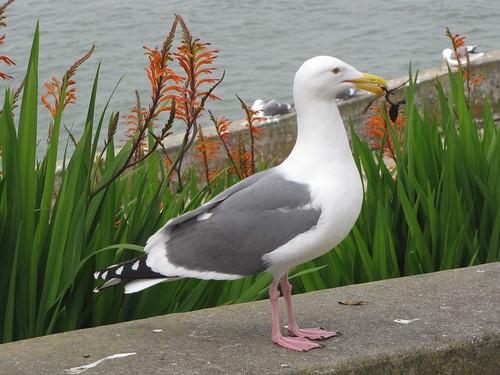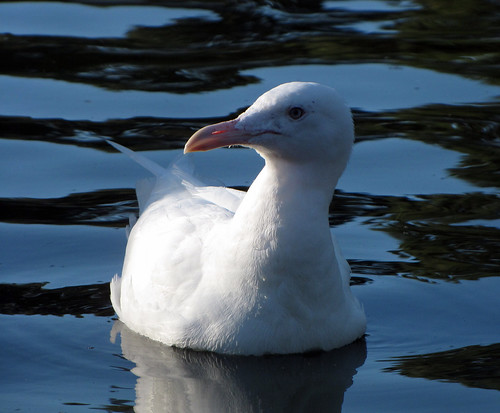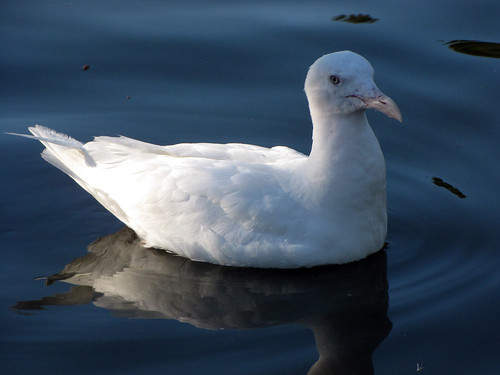Saturday, May 15, 2010
 the tales that odd plumage will tell you
the tales that odd plumage will tell you
12:42 PM | Posted by
Sweep Commander |
Edit Post
I'd been working on a few separate posts that in one way or another involved unexpected plumage and what you can know about a bird from an odd feather here or there. So, hell. It's one post now. Here we go.
This is a leucistic western gull that I met at Stow Lake in Golden Gate Park. Leucism is a condition which causes the afflicted to display unusually low levels of body pigmentation. It's similar to albinism, differing in ways I don't fully understand, but I do know that the presence of standard eye pigmentation is enough to establish that this guy is leucistic and not a true albino.
A google search revealed a report in the San Francisco Chronicle that an albino wegu hatched on Alcatraz in the summer of 1997. After I tracked down a former Alcatraz bird biologist, he informed me that the item was incorrect and that the hatchling in question was in fact leucistic! EUREKA!
With these birds quite often reaching fifteen years of age, it suddenly seemed possible that the leucistic gull of Golden Gate Park might have origins on Alcatraz.
Alas, the same bird biologist immediately informed me that the leucistic wegu disappeared while fledging, probably killed by a fellow gull or some other predator. Sometimes an investigation is dashed the moment it peeks your interest.
Still, we may be able to salvage an ounce of intrigue here. While this bird may not be a product of Alcatraz's gull colony, it may be the same as individual as this one, which visited Monterey over the winter of 2003/2004. The bird appears identical, and while that fact alone doesn't prove anything, this state of near complete leucism can't be all that common.
Other forms of aberrant plumage are far more common and a bit less intriguing:

In birder jargon, you'd say it lacks the typical mirrors on its outer primaries. In plain english, this gull's rear end, which is actually just the ends of its folded wings, lacks white spots. The following bird is a typically plumed wegu:


Sometimes odd plumage can indicate that the gull belongs to a different species entirely.

I captured this one flying over the island last winter. Superficially, it looks very similar to the gulls that make their home on Alcatraz.
But a closer examination reveals that unlike a western gull, this guy's head gets dark smudges during winter and it has grey -not black- wingtips. That's because this is a glaucous-winged gull, a close relative of our resident gulls, but a slightly larger, colder weather variant on the theme.
And what do we make of this bird?
We spotted this oddity nervously treading Alcatraz's parade ground over the winter. Unlike a western gull, it has a smudged head. Unlike a glaucous-winged gull, it has black wingtips.
It's a potential hybrid between the two.
Western gulls and glaucous-winged gulls hybridize freely along a stretch of coast extending from the border of Oregon and Washington up to the Canadian border. There, intermediate birds outnumber pure birds of either pedigree.
After observing many strange gulls over the winter with some visiting from as far north as the arctic, I've begun to wonder how gulls decide where to winter and where to establish themselves and breed.
Will birds be loyal to their winter haunts or could they spend one winter in Monterey and a few years later decide that Golden Gate Park is the place to be?
These are birds that take four years to develop their adult plumage and breed, meaning they have four years to explore. While there's apparently no truth to the rumors that this is part of the gulls' traditional variant on the Amish tradition of rumspringa, or that they spend this time backpacking in Europe, they may very well use these years to get a sense for preferred breeding and wintering grounds.
Lastly, when two gull species hybridize so extensively (and many others do as well) it poses serious problems for our general concept of a biological species. That's certainly the subject of a post to come.
Subscribe to:
Post Comments (Atom)
MEET THE ALCATRASH
Contact Maganrord
maganrord (at) gmail.com
Blog Archive
-
▼
2010
(73)
-
▼
May
(13)
- Alcatraz has babies! Cuteness overload!
- It's here...
- Rehash: Alcatraz is an awful place for geese to breed
- Now, we wait...
- A call to experts: is this the head of a juvenile ...
- Oh, bloody murder
- Mommy, what is "stacking"? Also, babies, babies, b...
- the tales that odd plumage will tell you
- Bird Census: American crow
- Update on our brave young falcon, raven news
- is the last Alcatraz gosling too big to fail?
- Young ravens hatch, parents behave cryptically (an...
- Gull fights revisited
-
▼
May
(13)



1 comments:
Just wanted to say that you guys have a fabulous site. I'm not a trained bird expert, but I've been devouring your posts and loving what I'm learning. If I get preoccupied with birds on the Bay it's your fault!
We have added a page to our site about birding on the island and included a link to your home page.
Thanks for a quality site in a world where so many blogs are 2mm deep, and please accept our compliments on your work.
Post a Comment
holla back!
Note: Only a member of this blog may post a comment.